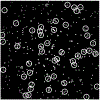RABiT-II: A Fully-Automated Micronucleus Assay System with Shortened Time to Result
- PMID: 30657421
- PMCID: PMC6446558
- DOI: 10.1667/RR15215.1
RABiT-II: A Fully-Automated Micronucleus Assay System with Shortened Time to Result
Abstract
In this work, we describe a fully automated cytokinesis-block micronucleus (CBMN) assay with a significantly shortened time to result, motivated by the need for rapid high-throughput biodosimetric estimation of radiation doses from small-volume human blood samples. The Rapid Automated Biodosimetry Tool (RABiT-II) currently consists of two commercial automated systems: a PerkinElmer cell::explorer Workstation and a GE Healthcare IN Cell Analyzer 2000 Imager. Blood samples (30 μl) from eight healthy volunteers were gamma-ray irradiated ex vivo with 0 (control), 0.5, 1.5, 2.5, 3.5 or 4.5 Gy and processed with full automation in 96-well plates on the RABiT-II system. The total cell culture time was 54 h and total assay time was 3 days. DAPI-stained fixed samples were imaged on an IN Cell Analyzer 2000 with fully-automated image analysis using the GE Healthcare IN Cell Developer Toolbox version 1.9. A CBMN dose-response calibration curve was established, after which the capability of the system to predict known doses was assessed. Various radiation doses for irradiated samples from two donors were estimated within 20% of the true dose (±0.5 Gy below 2 Gy) in 97% of the samples, with the doses in some 5 Gy irradiated samples being underestimated by up to 25%. In summary, the findings from this work demonstrate that the accelerated CBMN assay can be automated in a high-throughput format, using commercial biotech robotic systems, in 96-well plates, providing a rapid and reliable bioassay for radiation exposure.
Figures



References
-
- Fenech M, Morley AA. Measurement of micronuclei in lymphocytes. Mutat Res 1985; 147:29–36. - PubMed
-
- International Atomic Energy Agency (IAEA). Cytogenetic dosimetry: applications in preparedness for and response to radiation emergencies EPR-Biodosimetry. Vienna: IAEA; 2011. (https://bit.ly/2S7Hs0F)
-
- Ramakumar A, Subramanian U, Prasanna PG. High-throughput sample processing and sample management; the functional evolution of classical cytogenetic assay towards automation. Mutat Res Genet Toxicol Environ Mutagen 2015; 793:132–41. - PubMed
-
- Vrolijk J, Korthof G, Vletter G, van der Geest CR, Gerrese GW, Pearson PL. The automation of culturing and harvesting of human chromosome specimens. Histochemistry 1986; 84:586–93. - PubMed
Publication types
MeSH terms
Grants and funding
LinkOut - more resources
Full Text Sources
Other Literature Sources

